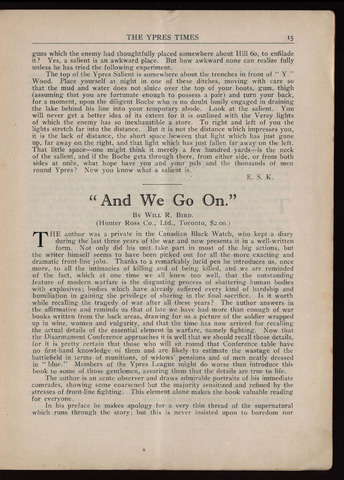THE YPRES TIMES
15
guns which the enemy had thoughtfully placed somewhere about Hill 60, to enfilade
it? Yes, a salient is an awkward place. But how awkward none can realize fully
unless he has tried the following experiment.
Thé top of the Ypres Salient is somewhere about the trenches in front of Y
Wood. Place yourself at night in one of these ditches, moving with care so
that the mud and water does not sluice over the top of your boots, gum, thigh
(assuming that you are fortunate enough to possess a pair) and turn your back,
for a moment, upon the diligent Boche who is no doubt busily engaged in draining
the lake behind his line into your temporary abode. Look at the salient. You
will never get a better idea of its extent for it is outlined with the Verey lights
of which the enemy has so inexhaustible a store. To right and left of you the
lights stretch far into the distance. But it is not the distance which impresses you,
it is the lack of distance, the short space beween that light which has just gone
up, far away on the right, and that light which has just fallen far away on the left.
That little spaceone might think it merely a few hundred yardsis the neck
of the salient, and if the Boche gets through there, from either side, or from both
sides at once, what hope have you and your pals and the thousands of men
round Ypres? Now you know what a salient is.
E. S. K.
By Will R. Bird.
(Hunter Ross Co., Ltd., Toronto, $2.00.)
THE author was a private in the Canadian Black Watch, who kept a diary
during the last three years of the war and now presents it in a well-written
form. Not only did his unit take part in most of the big actions, but
the writer himself seems to have been picked out for all the more exacting and
dramatic front-line jobs. Thanks to a remarkably lucid pen he introduces us, once
more, to all the intimacies of killing and of being killed, and we are reminded
of the fact, which at one time we all knew too well, that the outstanding
feature of modern warfare is the disgusting process of shattering human bodies
with explosives; bodies which have already suffered every kind of hardship and
humiliation in gaining the privilege of sharing in the filial sacrifice. Is it worth
while recalling the tragedy of war after all these years? The author answers in
the affirmative ana reminds us that of late we have had more than enough of war
books written from the back areas, drawing for us a picture of the soldier wrapped
up in wine, women and vulgarity, and that the time has now arrived for recalling
the actual details of the essential element in warfare, namely fighting. Now that
the Disarmament Conference approaches it is well that we should recall those details,
for it is pretty certain that those who will sit round that Conference table have
110 first-hand knowledge of them and are likely to estimate the wastage of the
battlefield in terms of munitions, of widows' pensions and of men neatly dressed
in blue." Members of the Ypres League might do worse than introduce this
book to some of those gentlemen, assuring them that the details are true to life.
The author is an acute observer and draws admirable portraits of his immediate
comrades, showing some coarsened but the majority sensitized and refined by the
stresses of front-line fighting. This element alone makes the book valuable reading
for everyone.
In his preface he makes apology for a very thin thread of the supernatural
which runs through the story; but this is never insisted upon to boredom nor

